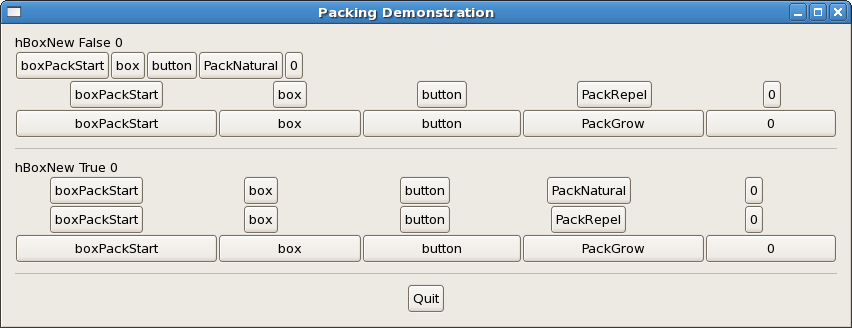
The base of all widgets here is a vertical box, which itself is a child of the
window. The child widgets are not displayed homogeneously and there is no
additional spacing (other than the standard spacing). There are six horizontal
boxes in the vertical box, as defined by the function makeBox,
which has the type as shown. Furthermore, there are two labels in the vertical
box as well as two horizontal separators. The last widget is the Quit
button, whose onClicked signal is attached to the
mainQuit function.
The separators are created with hSeparatorNew and they are spaced
by boxPackStart with a padding of ten pixels. The labels are
created by labelNew which takes a Maybe String and
their positioning is set by miscSetAlignment to be left and top
justified.

The function makeBox :: Bool -> Int -> Packing -> Int -> IO
HBox demonstrates how Gtk2Hs widgets fit into the Haskell type system.
Packing is just a type like Int and Bool
and IO HBox is just like IO String in the usual
IO. The function creates five buttons, labels them with the
appropriate text and packs them into a horizontal box. The function is then
used in the main program to create the desired ways of packing.
import Graphics.UI.Gtk
main :: IO ()
main = do
initGUI
window <- windowNew
vbox <- vBoxNew False 0
set window [containerBorderWidth := 10,
windowTitle := "Packing Demonstration",
containerChild := vbox]
label1 <- labelNew (Just "hBoxNew False 0")
miscSetAlignment label1 0 0
boxPackStart vbox label1 PackNatural 0
box1 <- makeBox False 0 PackNatural 0
boxPackStart vbox box1 PackNatural 0
box2 <- makeBox False 0 PackRepel 0
boxPackStart vbox box2 PackNatural 0
box3 <- makeBox False 0 PackGrow 0
boxPackStart vbox box3 PackNatural 0
sep1 <- hSeparatorNew
boxPackStart vbox sep1 PackNatural 10
label2 <- labelNew (Just "hBoxNew True 0")
miscSetAlignment label2 0 0
boxPackStart vbox label2 PackNatural 0
box4 <- makeBox True 0 PackNatural 0
boxPackStart vbox box4 PackNatural 0
box5 <- makeBox True 0 PackRepel 0
boxPackStart vbox box5 PackNatural 0
box6 <- makeBox False 0 PackGrow 0
boxPackStart vbox box6 PackNatural 0
sep <- hSeparatorNew
boxPackStart vbox sep PackNatural 10
quitbox <- hBoxNew False 0
boxPackStart vbox quitbox PackNatural 0
quitbutton <- buttonNewWithLabel "Quit"
boxPackStart quitbox quitbutton PackRepel 0
onClicked quitbutton mainQuit
onDestroy window mainQuit
widgetShowAll window
mainGUI
makeBox :: Bool -> Int -> Packing -> Int -> IO HBox
makeBox homogeneous spacing packing padding = do
box <- hBoxNew homogeneous spacing
button1 <- buttonNewWithLabel "boxPackStart"
boxPackStart box button1 packing padding
button2 <- buttonNewWithLabel "box"
boxPackStart box button2 packing padding
button3 <- buttonNewWithLabel "button"
boxPackStart box button3 packing padding
button4 <- case packing of
PackNatural -> buttonNewWithLabel "PackNatural"
PackRepel -> buttonNewWithLabel "PackRepel"
PackGrow -> buttonNewWithLabel "PackGrow"
boxPackStart box button4 packing padding
button5 <- buttonNewWithLabel (show padding)
boxPackStart box button5 packing padding
return box
The image below shows the effects of resizing the window horizontally. In the first group, with homogeneous set to False horizontal resizing leaves the first row of buttons as it is, spaces the second row evenly, and enlarges the buttons in the third row. In the second group the buttons are set to be packed homogeneously, and the first two rows will look the same. Resizing the window vertically just adds extra space at the end, because the vertical box was initialized with False.
